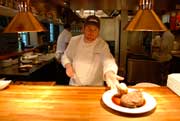 Where Are They? We Must Ask
Where Are They? We Must Ask
He’s a hustler, he has to be, the last cash he saw from selling oysters went out with the tide on May 15th, but he finds a way. He has been on the water since he was five. There are fish to broker, mushrooms to forage, herbs to grow and barter with. There are lawns to cut and a hundred other little labors to help stem the tide, so he can keep his life on the water. He does it all while still tending his oyster beds – raking, grooming, breaking, shuttling the wild oysters to prepare for the day when the season opens again.
Through a hidden cut off Lucy Creek the skiff skips swiftly through the skinny water, drifting on the tight corners of a shimmering saltwater maze, each turn a still life, until seabirds take flight and fly before us as we intrude upon a world within a world. It is place witnessed only for the hours of the low tide, punctuated by craggy grey mounds of cluster oysters naked against the black shoreline, behind curtains of towering green sea grass. We throttle down at a bank of wild oysters he has worked by hand, separating the singles from clusters, and left to grow alone in this secret wild place. His labor left unpaid for months, we come to collect.
There is no magic at this point. Bend at the back, find or create a single, toss it in the basket. Six oysters fly from his hand for my every one, but he is reassuring, “you have to get the eye for them,” he tells me, “you’ll get it.” Rake, seek, toss, repeat, the spot is worked until it is deemed time to move on – to the next spot, and the next.
We take on three bushels before the tide tells him it’s time to move on. Though I am used to working on my feet and in the heat of the kitchen, I am grateful for the reprieve. Full throttle so as to stay lean within the water we make way, to a tidal flat even deeper in the marsh grass jungle where a cache of culled oysters lie in wire cages waiting to be taken to market. Heavy summer rain has lowered the salt content of the water and even though there is a permit in place for early harvest, these oysters lack the salinity that gives them the unique flavor that speaks of place, and they will have to wait.
Cage upon cage are rinsed, culled, stacked and re-stacked, our three bushels find their new home among them. All around us in the slowly rising tide tiny shrimp and baitfish ripple water’s surface. I stand muddy, sweaty, and worn watching him survey the crop until satisfied that all we can do is done, we push off.
Full throttle once again the boat rips the s turns, homeward bound against the incoming tide, we catch each other’s glance, and nodding, simply smile. I get it.
On the way back to the restaurant there’s talk of mortal things, of mortgages,
of marriage, of children. To choose this way of life makes all of those things difficult, and I am left to wonder what will become of this trade.
Where are those boys? Those little men on oyster boats who spend the day in father’s tow, up silent creeks, on river bottoms, working on the waning tide below a towering field of brilliant green sea grass swaying in the breeze; smelling of child’s sweat and pluff mud thinking, “I want to be an oyster man, like my father.”
I hope they are out there with the stark white herons, the finning reds, the osprey on the hunt, and that nature’s call is strong enough to bring them back as men. I hope as men their hearts will swell when church bells ring, and they find an outstretched hand to take and watch the hometown parade. I hope they may know a life on the water that provides for a family, so that their sons and daughters will take those same trips up silent creeks…







